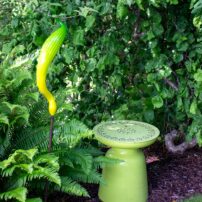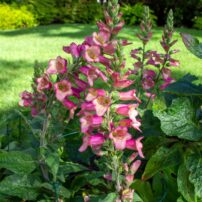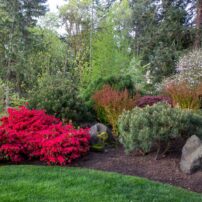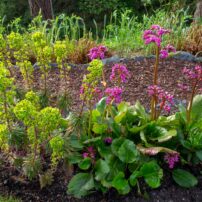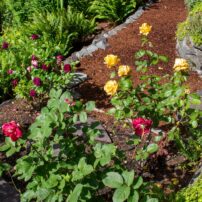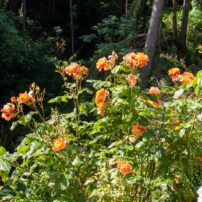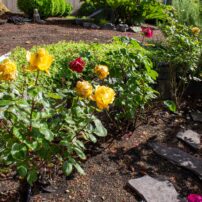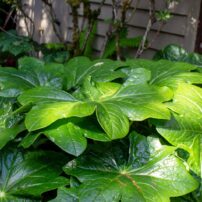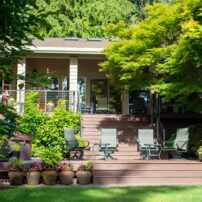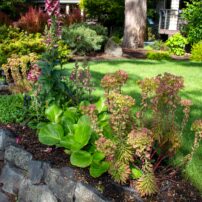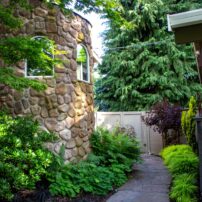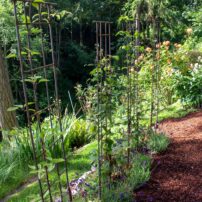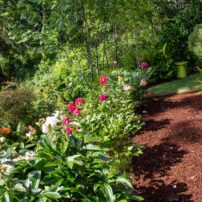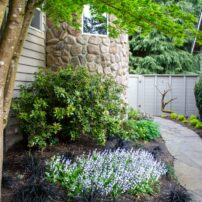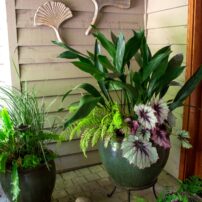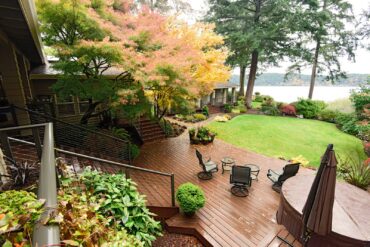
Transplanting themselves from the Bay Area to the Pacific Northwest, Barbara McFarren and Stan Noel found their lovely Gig Harbor view home in 2008, completing the move a year later. The couple was attracted in part by the “good bones” of the garden areas surrounding the house — colorful, mature maples and large shrubs filled the rambling grounds on the property, along with an exuberant selection of perennials and ferns.
This team of avid gardeners work together on the extensive grounds surrounding their home and have found real joy and connection with each other during the process.
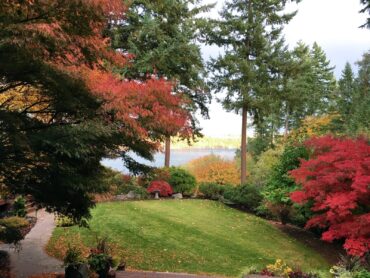
Neither McFarren nor Noel had a great deal of gardening experience prior to coming to Gig Harbor, but each of them enjoyed tending the outside spaces they had in places they lived previously. A lot has changed since the couple arrived in 2009, and Noel smiles when he says, “I thought the yard was just fine the way it was.” McFarren reminisces, “At this point, nearly every plant on the property has been repositioned.”
The previous homeowner was an avid gardener who loved all sorts of plants. She was particularly fond of perennials, rhododendrons and roses, resulting in beds overflowing with plant material that required a lot of maintenance to keep them looking neat and tidy. One afternoon, sitting with a glass of wine, McFarren suggested redesigning the garden area in front of the guest house and a bed in the central part of the yard. At that moment, a nearly complete revision of the plantings on the property began.
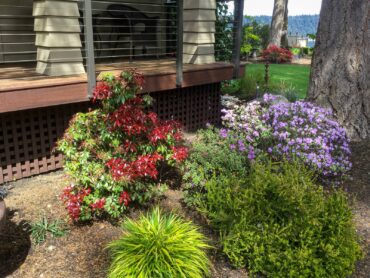
Soon the couple found themselves deep in redesigning and remediating pathways and watering system, and working to preserve their view of the Tacoma Narrows beneath the bluff on which the home sits.
McFarren joined the Northwest Perennial Alliance, where she began learning about the nuances of Northwest gardening, and soon after employed the services of garden designer Sue Goetz to help with the planning process. Noel set about drawing architectural plans for refurbishing the deck and railings. He found flagstone to cover an existing concrete walkway and took on the task of supervising various garden workers. He used his engineering background to solve the problem of the slippage of the property into the ravine that borders them on the south side of the lot.
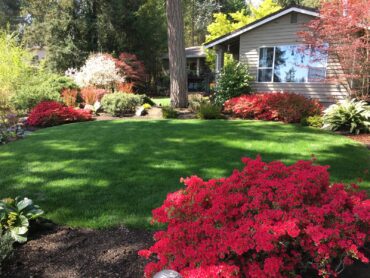
An Abundance of Plants
As all gardening projects go, the plan slowly unfolded, got modified and eventually reached the pleasing result evident today. The grounds consist of open and sunny spots, shaded and protected areas next to buildings, deep dry shade near the street side of the property, and beds of colorful conifers and evergreens intended to draw the eye from the expansive deck and patio area to the vista across the water at Point Defiance. McFarren and Noel have named the various areas of their property for clarification in communication while discussing moving plants or cultivating certain areas.
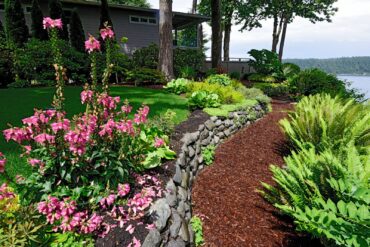
A shady north-facing wall at the driveway entrance is artfully planted with Japanese tassel ferns, large burgundy hellebores, chartreuse sweet flag and trellised winter-blooming, white Camellia “Setsugekka.” McFarren located the trellises locally to coordinate with the style of the house, and Noel engineered their attachment to the wall.
Continuing up the drive, a retaining wall is planted with a selection of dwarf daphne and perennial geranium, interspersed with terra cotta pots filled with creeping jenny, santolina and heliotrope, allowing the eye to continue to the understory plantings above, which help to screen the property from the next door neighbors.
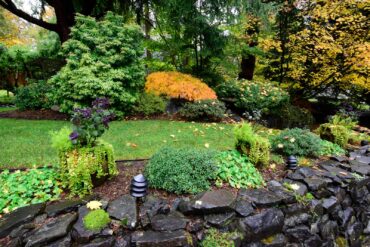
“The positioning of the home and grounds is ideal,” Noel says. “Because of the topography of the shoreline and the placement of the home on the lot, we are not overlooked by neighbors and we seldom hear neighborhood noise.”
The front porch stays in the shade all day, offering a sheltered space for breathtaking, large pots filled with cast iron plant, several types of shade-loving ferns and rex begonias, which flank the double front doors and stained-glass entry windows. A bed next to the porch does catch some sun and is planted with a few fuchsias, hellebores and an attractive large pot that features ‘Wissel’s Saguaro’ cypress trees surrounded by low-growing shrubs and ground covers.
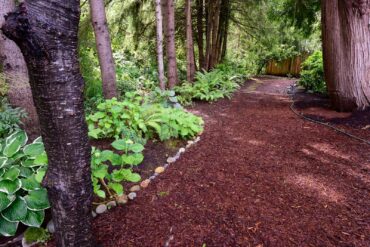
The south-facing border of the home sports a mature peanut butter tree (Bunchosia argentea) with beautiful foliage. A huge stump, which remains from a tree that had to be removed, supports a large planter filled with ‘Evergold’ sedge. This is one of the plants used repeatedly throughout the various garden areas, but is unfortunately ravaged by rabbits. McFarren has solved the rabbit problem by putting this favored plant in planters, elevated out of reach of the critters.
Foundation plantings along the house include a mountain laurel (Kalmia latifolia), which was moved from another area where it wasn’t doing well, and fuchsias and ferns. Along the fence, giant, potted hostas interspersed with large ferns and hellebore provide privacy. The potted hostas provide defense against the slugs and remain in place year round.
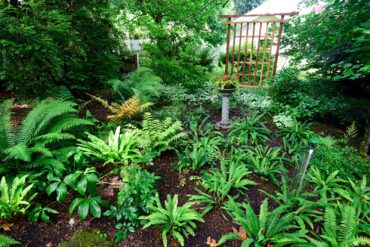
Stepping stones lead the way along a fern berm and to a series of rock cairns and bamboo, marking the entrance to the “Buddha Garden.” Steeped in deep shade, this area provides a natural area for ferns, astilbes moss and a brilliant ‘Rainbow’ leucothoe. Statuary, a tinkling wind bell and a bench provide an ideal spot for quiet contemplation and meditation.
Another shady spot on the water side of the house is shielded by the privacy fence that surrounds the back of the hot tub. Massive, 14-inch leaves of a podophylum jump from the ground and reach toward a lush clematis that climbs up to the top of the deck railing above.
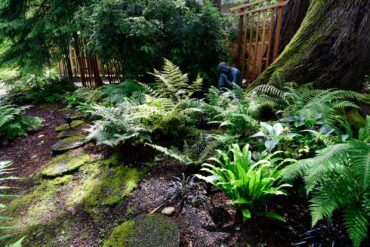
A few feet away, where the sun reaches during most of the day, a 12-foot ‘Gold Dust’ Japanese acuba lends a softness to the corner of the deck where the steps lead down to the lower level. The opposite corner of the deck below the stairs contains a deep garden area with a very large sarcococca, massive sword fern and smaller Japanese maple, all anchored by an overtowering maple that lends shade and texture while softening the corner of the house.
The roomy deck looks out over the back lawn to an island bed tastefully planted with a large golden cypress, colorful red Japanese maple, prostate spruce and a birdbath. The eye travels beyond to a drift of flame barberry, then to the water below and on to Point Defiance. To the left, or north side of the property, sits the guest house. Potted ‘Evergold’ sedge line the deck, out of reach of hungry rabbits, while twin Hinoki cypress flank the stairway. In summer, a container planting of nearly black canna, burgundy heuchera, fern and brilliant orange begonias mark the entrance to the guest quarters.
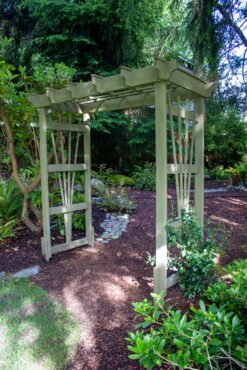 A pathway wanders from the island bed along the “Outer Bank,” where native plants creep up the wall of the ravine, interspersed with mallow and mullein. Some remaining tall, red crocosmia and yarrow from the previous owner’s collection peek up over the top of a cultivated row of peony plants lining the path. A low-slung retaining wall on the opposite side of the path is topped by several varieties of stonecrop that nestle between the rocks, enjoying the moisture and warmth the rocks provide.
A pathway wanders from the island bed along the “Outer Bank,” where native plants creep up the wall of the ravine, interspersed with mallow and mullein. Some remaining tall, red crocosmia and yarrow from the previous owner’s collection peek up over the top of a cultivated row of peony plants lining the path. A low-slung retaining wall on the opposite side of the path is topped by several varieties of stonecrop that nestle between the rocks, enjoying the moisture and warmth the rocks provide.
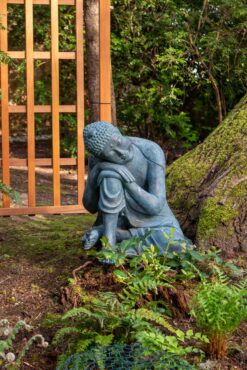 In this area, Noel did a substantial amount of remediation work using tie-backs into wood and reinforced with concrete to prevent the yard from slipping into the ravine. The native plants and blackberries need to be cut back occasionally, but their roots help to hold the hillside in place.
In this area, Noel did a substantial amount of remediation work using tie-backs into wood and reinforced with concrete to prevent the yard from slipping into the ravine. The native plants and blackberries need to be cut back occasionally, but their roots help to hold the hillside in place.
The “Outer Bank” path turns toward Puget Sound and becomes the “Narrows Path,” where multiple rose bushes now line the outside of the pathway while the stone retaining wall continues along with its capping of stonecrop. Here, colorful ‘Illumination Flame’ digiplexis, hebes, a dwarf hydrangea and ‘Blazeaway’ Scotch heather add color and aesthetic appeal.
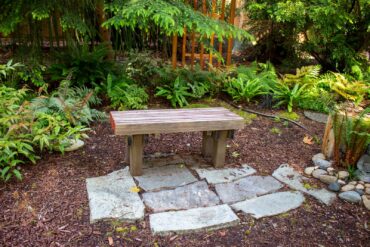 When you step back up onto the lawn area nearest the edge of the bluff, a very large Gunnera stands sentry. Noel dug a pit and used a pool liner with a little drainage and a dripper to give this water-loving plant enough moisture to thrive. It grows to 6-8 feet in summer, sporting gigantic leaves, but dies back in the winter.
When you step back up onto the lawn area nearest the edge of the bluff, a very large Gunnera stands sentry. Noel dug a pit and used a pool liner with a little drainage and a dripper to give this water-loving plant enough moisture to thrive. It grows to 6-8 feet in summer, sporting gigantic leaves, but dies back in the winter.
Several varieties of rhododendron, all harvested from other parts of the property, now line the fence that separates the home from the next-door neighbors. A small seating area accented with speckled yellow-green pots allows for sitting and gazing at the garden with a different perspective than from the seating areas on the deck. A brilliantly blue-flowered, perennial ‘Roxanne’ geranium spills happily from one pot, while a coppery New Zealand flax offers a spiky contrast in textures. A third and smaller pot sports peachy pink, low-growing lewisias.
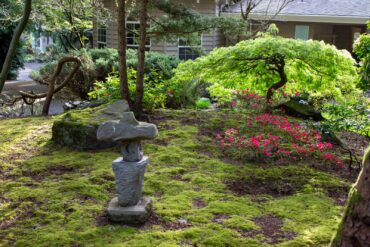 Turning back away from Puget Sound, a full view of the backside of the house is revealed. The upper and lower decks are tastefully accented with various sizes of pots containing evergreens or perennials for year-round interest, along with a few annuals such as colorful begonias tucked in here and there for summer color.
Turning back away from Puget Sound, a full view of the backside of the house is revealed. The upper and lower decks are tastefully accented with various sizes of pots containing evergreens or perennials for year-round interest, along with a few annuals such as colorful begonias tucked in here and there for summer color.
As the eye travels around the planted beds and borders, the secret to success in this carefully thought-out landscape becomes apparent.
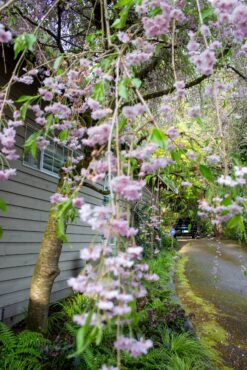 “Repeating plants for color and texture and grouping them together gives a continuity to the entire property,” McFarren says. Noel follows by saying, “Don’t just see a plant and like it and buy it. Make a plan and use mass plantings for maximum effect.”
“Repeating plants for color and texture and grouping them together gives a continuity to the entire property,” McFarren says. Noel follows by saying, “Don’t just see a plant and like it and buy it. Make a plan and use mass plantings for maximum effect.”
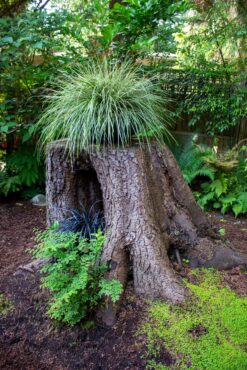 Melding their interests and talents, learning together and working together on redesigning the landscapes around their home have given this couple a connectedness they both fully enjoy. Noel is an audiophile and loves playing with his electronics, along with getting out on the golf course when possible. McFarren practices her lifelong love of playing the piano on a daily basis, is an avid knitter, and in the winter works many hours on family genealogy.
Melding their interests and talents, learning together and working together on redesigning the landscapes around their home have given this couple a connectedness they both fully enjoy. Noel is an audiophile and loves playing with his electronics, along with getting out on the golf course when possible. McFarren practices her lifelong love of playing the piano on a daily basis, is an avid knitter, and in the winter works many hours on family genealogy.
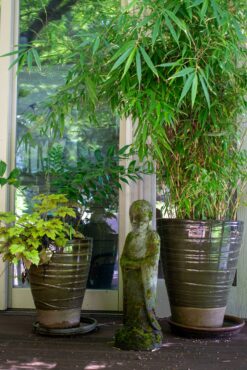 In the garden, Noel does the “heavy lifting,” as he calls it. He mows, edges, mulches and moves plants when needed. He redesigned the deck that existed when they bought the house to include a dais for the hot tub, with a privacy wall and raised floor level to allow easier access. He has worked over every foot of the watering system as well as designing and installing all of the outside lighting.
In the garden, Noel does the “heavy lifting,” as he calls it. He mows, edges, mulches and moves plants when needed. He redesigned the deck that existed when they bought the house to include a dais for the hot tub, with a privacy wall and raised floor level to allow easier access. He has worked over every foot of the watering system as well as designing and installing all of the outside lighting.
McFarren chooses plants and propagates those she wishes to expand to other spots in beds and borders. She uses her artistic eye to combine colors, textures and sense of scale.
The careful placement of flowering plants and those with seasonal foliage, and mixing deciduous with evergreens has given this beautiful, bluff-side property something to enjoy at every season of the year. Brilliant azaleas bloom in spring and colorful maples change their gowns from new spring growth to greens and reds in summer, and yellows to bronze to flaming red in autumn. The chartruse and lime of Japanese forest grass in summer, and sweet flag and sedge year round, combined with black mondo grass, define walkways and points of interest, while the bare branches of deciduous trees and shrubs reveal the bones of the garden in winter.
This is truly a garden to be enjoyed for all seasons.




